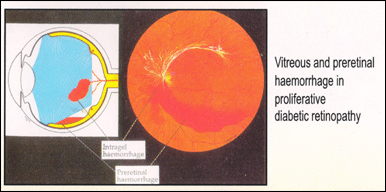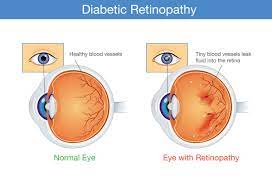DIABETIC RETINOPATHY
What is Diabetic Retinopathy?
Diabetic Retinopathy is today one of the leading causes of Preventable Blindness in India. One-Third of patients with type-2 have retinopathy at diagnosis, increasing to two-third within 20 years.
Disorder of retinal blood vessels.
Increased incidence with longer duration & poor blood sugar control.
Associated factors like Hypertension, anemia, Nephropathy increase risk of DMRP
In the quest of controlling blood sugar levels, damage to vision many times goes unnoticed. However, if detected and diagnosed early, blindness due to Diabetic Retinopathy can be prevented. All it requires is a regular complete fundus examination.
Forms of Diabetic Retinopathy

Backround Retinopathy
Background Retinopathy is an early stage of diabetic retinopathy and progresses slowly over the years. The retina usually shows evidence of tiny blood spots and fatty deposits. The majority of patients may show a gradual blurring of vision which can often go unnoticed. In some patients, blood vessels leak at the macula, the part of the retina responsible for central vision, causing loss of vision, due to macular edema.
Proliferative Retinopathy
Proliferative Retinopathy Develops from the background retinopathy and is responsible for most of the visual loss in diabetes left untreated. Bleeding occurs due to rupture of abnormal blood vessels. The patient may see few floating spots or complete loss of sight. Though there is no pain, this severe form of diabetic retinopathy requires immediate medical attention. Fibrous scar tissue may pull on retina causing retinal detachment. A special photographic process using a hightech, high resolution fundus camera is very helpful in detecting effects of diabetic retinopathy. This is known as fundus flourescein angiography (FFA) and will sometimes be recommended by your ophthalmologist. The procedure involves injection of dye through the arm into the blood stream. As the dye is carried to the eye, photographs of the retina are taken showing areas of leakage or poor blood flow.

Why FFA?

It shows areas of leakage or poor blood flow.
Demarcates the area requiring laser photocoagulation.
Analyses status post photocoagulation & determines the necessity and extent of re treatment if required.
daibetic eye strain
Important Points To Note
DMRP often has no early warning signs.
Don′t Wait For Symptoms!
Successful treatment of DMRP depends on early detection.
Newly diagnosed Diabetics should undergo an eye checkup.
All Known Diabetics are advised to undergo a comprehensive dilated eye examination at least once a year.
Strict control of diabetes & elevated blood pressure & cholesterol reduces risk of vision loss.

Treatment For Diabetic Retinopathy
Control of blood sugar and blood pressure are important but progression of retinopathy may occur despite all medical efforts. If diabetic retinopathy is detected early, photocoagulation by laser may stop continued damage Even in advanced stages of the disease, it can reduce the chance that a patient will have severe visual loss. Laser treatment is used to seal the abnormal leaking blood vessels. This Procedure focuses a powerful beam of laser light onto the damaged retina to from tiny scars inside the eye. The scars reduces abnormal vessels growth and cause existing ones to shrink and close. Laser treatments are usually carried in an outpatient setting. They do not require special preparation or admission to hospital. Laser cannot be used successfully in all patients. Advanced cases with vitreous bleeding into the eye and scar tissue formation require a procedure called vitrectomy together with other sophisticated surgical procedures.
Anil Eye hospital provides the facility of detection and follow up of Diabetic Retinopathy with sophisticated investigative modalities including Fundus Angiography and photography.
